
Aquarium size is actually pretty useless to determine the number or size of fish an aquarium can stock or to size filters. Biofiltration surface area per metabolic pound of fish is much more useful. Calculations say that each metabolic pound of fish needs, in very general terms, 5 square feet of effective biomedia surface ABSOLUTE MINIMUM in order to effectively oxidize ammonia.
But ammonia oxidation is not the only function of filter media. The one metabolic pound of fish require, in very general terms, at least 100 square feet of effective biomedia surface in order to have crystal clear, bacteria free, healthy water. Now this is actually a continuum with a large number of variables impacting it. This is not a “cast in stone” number. For instance, 20 square feet per metabolic pound of fish will very generally give fairly healthy fish with decent water clarity.

To be reasonably safe with a cushion for the health of the fish we recommend a minimum of 20 sq. ft. of effective filter media surface area per metabolic pound of fish minimum. Using the 20 sq. ft. figure:
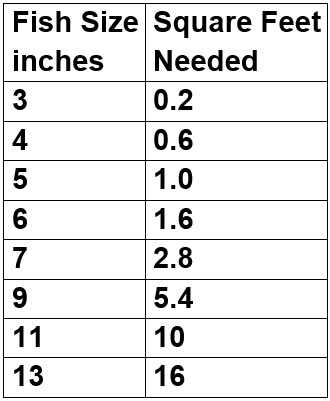
Note that if one is of a mind set to only do ammonia oxidation 5 sq. ft. per metabolic pound of fish is possible but the fish won’t be very healthy. That would be one fourth the above level. And if one wants very healthy fish with crystal clear water at least 100 sq. ft. per metabolic pound of fish is required, five times the above level. Note that some fish such as blackwater fish like neons, discus and Oscars REQUIRE at least 40 sq. ft. per metabolic pound of fish and preferably 200.
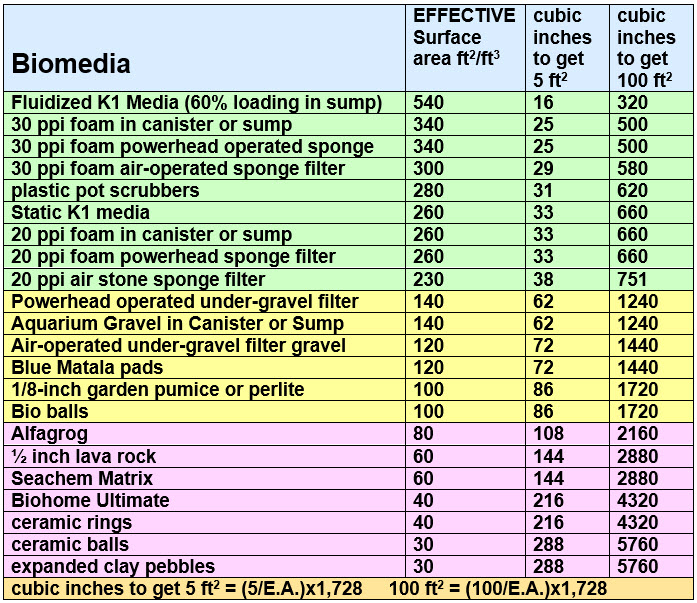
It is important to note that the Fluidized K1 efficiency is per cubic foot of filter, NOT per cubic foot of K1 filter media. Big difference!
The chart above can be combined with this chart to give a clear picture for any given filter arrangement:
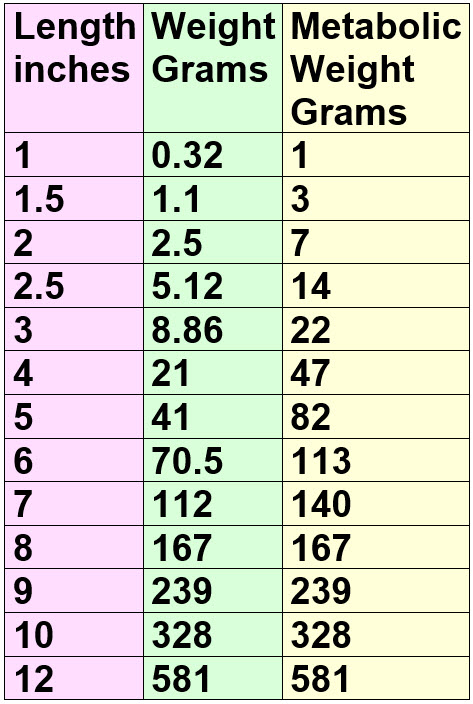
One pound is 454 grams. So if one has ten 82 gram five inch fish, this is (82×10)/454 = 1.8 pounds metabolic weight. So a canister filter that is ten inches by ten inch by twelve inches (1,200 cubic inches) and filled with pot scrubbers will give one 1,200/620 = 1.9 pounds of healthy fish swimming in clear water (100 square feet per pound of fish metabolic weight).

As for filters, simple math calculations say:
- A twenty gallon aquarium set up as a K1 fluidized bed sump with 15 gallons of fluidized bed that is 60% K1 media will give on the order of 1082 square feet of effective biomedia surface.
- A ten gallon aquarium set up as a K1 fluidized bed sump with 5 gallons of fluidized bed that is 60% K1 media will give on the order of 361 square feet of effective biomedia surface.
- A foam filled large canister like the FX6 has about 150 sq. ft. of effective biomedia (the foam in an FX is very good biological media)

- Other four to five gallon canisters like a Sunsun 303 packed only with static (STATIC) K1 micro Kaldnes media or pot scrubbers have 100 to 120 sq. ft.
- Two inches of gravel in a powerhead lift 36 inch by 18 inch 50 gallon under gravel filter has 105 sq. ft. effective surface area.
- Two inches of gravel in a air lift 36 inch by 18 inch 50 gallon under gravel filter has 90 sq. ft. effective surface area.
- A typical cheap sponge filter with a powerhead lift has 40 to 80 sq. ft. depending on the size of the sponge.
- A typical cheap sponge filter with air bubble lift tub has 30 to 60 sq. ft. effective surface area, depending on its size.
- A bottom to top hang on back filter filled with sponge or pot scrubbers has an effective surface area of 20 to 40 sq. ft., depending on its size.
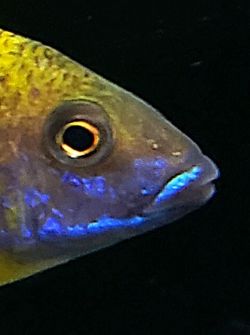
- Canisters such as Sunsun 303 packed only with lava rock, Matrix, Biohome, bioballs and/or ceramic rings has 10 to 20 sq. ft, depending on its size.
- A bottom to top hang on back filter filled with Matrix, Biohome or ceramic rings has an effective surface area of 4 to 8 sq. ft., depending on its size
- A cartridge hang on back where the cartridge has been replaced with foam or pot scrubbers has 2 to 6 square feet, depending on its size.

- A typical cartridge hang on back filter with the cartridges still in place has only 1 to 2 sq. ft., depending on its size. This means that most cartridge filters in most stocking situations only do ammonia oxidation well and will give poor fish health and frequent fish deaths. The deaths typically have no clear explanation as to “why” they happened.
Just do the math. Figure out the size of each of the fish in the aquarium and count them up. Add the square footage required up. Then see if the filter and media are rated to do the trick.

These numbers are ONLY gross approximations. Do not obsess over them. There are a huge number of variables affecting the ability of a filter to function:
- Temperature, the higher the temperature the better beneficial bacteria grow
- Protein content of the food. The high the protein content the less “bad” bacteria are produced in the water column. I always buy the highest protein food I can find.
- Aeration, the more the aeration the better beneficial bacteria work
- Flow and degree of turbulence will affect efficiency and cannot be calculated or predicted very accurately
- pH, KH, GH and phosphates in the water all affect it in very unpredictable ways
- The “maturity” of the filter and the tank A “mature” or “seasoned filter and aquarium can handle a lot more that a one month old filter and aquarium.
- And the “ecology” of the tank will vary, often in very surprising ways.
- The tiny single celled protozoan community is surprisingly important to the function of an aquarium filter and the composition of this community varies in the extreme from tank to tank.
So do not try to get exactly “100 square feet per metabolic pound of fish”. This is NOT an exacting science.

Test of Filters
Ammonia was added to forty gallon aquariums with various filters where the filter was filled with the media recommended by the supplier. The resulting ammonia levels were measured three days later, and the amount of ammonia added adjusted according to the measured ammonia level. These are the results:
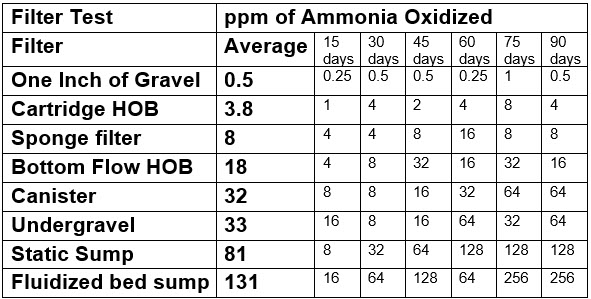
This test correlate reasonably well with the numbers in the list above (the sump was a ten gallon with K1 and the other filters, including a Sunsun 303 canister, had the media they came with).

Note that the amount of ammonia even a very heavily stocked tank might get from fish might be 2 ppm in three days. So ammonia oxidation in an established tank with ANY filter is rarely a problem. But for crystal clear, healthy water in a heavily stocked tank the cut off number EFFECTIVELY becomes 40 ppm ammonia (twenty times the ammonia oxidation numbers). So crystal clear healthy water is limited to canisters, under-gravels and sumps in a heavily stocked tank.
For the complete test details go to this link:
8.1.1. Filter Test
For more on how to calculate filter volume go to these articles:
8.8. Filter and Media Design
7.3. Media Volume
7.6. Required Aquarium Filter Media Surface Area
.
Return to Filter Menu
.
Aquarium Science Website
The chapters shown below or on the right side in maroon lead to close to 400 articles on all aspects of keeping a freshwater aquarium. These articles have NO links to profit making sites and are thus unbiased in their recommendations, unlike all the for-profit sites you will find with Google. Bookmark and browse!
.

mike says
I did a little checking, tore apart a pot scrubber measured the width of the strand at 1mm wide. Placed the unrolled scrubber over a 3″ pvc and pulled 8 meters of strand from 10 rows of stitching. Counted 140 to 150 rows of stitching on a couple of scrubers.
so 800 mm per row of stitching with 2 sides of the material thats 1600 mm sq area per row x145 rows average. Thats 232,000 sq mm area per scrubber, convert that to sq ft 2.49 square ft per scrubber.. round out a bit thats 50 pot scrubbers per pound of fish metobolic weight with a bit of wiggle room.
I picked up 7 packs of 7 scrubbers at the dollar store for under 10 bucks.
Cheapest filter media ever made.
Also, the material is 100% nylon.